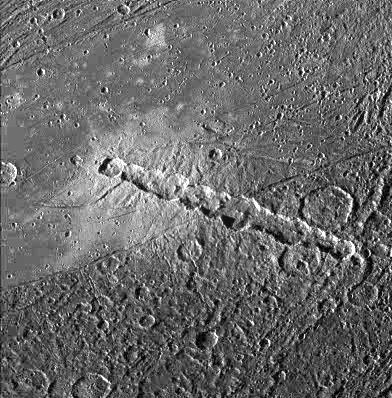Bestand:Chain of impact craters on Ganymede.jpg
Chain_of_impact_craters_on_Ganymede.jpg (392 × 398 pixels, bestandsgrootte: 51 kB, MIME-type: image/jpeg)
Bestandsgeschiedenis
Klik op een datum/tijd om het bestand te zien zoals het destijds was.
| Datum/tijd | Miniatuur | Afmetingen | Gebruiker | Opmerking | |
|---|---|---|---|---|---|
| huidige versie | 21 jul 2006 22:14 |  | 392 × 398 (51 kB) | Peter439 | {{Information |Description=A chain of craters on Jupiter's moon Ganymede, probably caused by the impact of a fragmented comet. The picture covers an area about 120 miles wide. |Source= from http://antwrp.gsfc.nasa.gov/apod/ap011215.html |Date=1994 |Author |
Bestandsgebruik
Dit bestand wordt op de volgende pagina gebruikt:
Globaal bestandsgebruik
De volgende andere wiki's gebruiken dit bestand:
- Gebruikt op be.wikipedia.org
- Gebruikt op ca.wikipedia.org
- Gebruikt op cs.wikipedia.org
- Gebruikt op da.wikipedia.org
- Gebruikt op de.wikipedia.org
- Gebruikt op en.wikipedia.org
- Gebruikt op en.wikiversity.org
- Draft:Original research/Radiation astronomy
- User:Marshallsumter/Keynote lectures (draft)/Meteor radiation astronomy
- Solar System, technical/Ganymede
- User:Marshallsumter/Rocks/Rocky objects/Ganymede
- Object astronomy
- Portal:Radiation astronomy/Lecture
- Portal:Radiation astronomy/Lecture/3
- Radiation/Astronomy
- User:Marshallsumter/Radiation astronomy/Craters
- Gebruikt op es.wikipedia.org
- Gebruikt op eu.wikipedia.org
- Gebruikt op fi.wikipedia.org
- Gebruikt op fr.wikipedia.org
- Gebruikt op fr.wikibooks.org
- Gebruikt op fr.wiktionary.org
- Gebruikt op gl.wikipedia.org
- Gebruikt op he.wikipedia.org
- Gebruikt op hr.wikipedia.org
- Gebruikt op it.wikipedia.org
Globaal gebruik van dit bestand bekijken.


